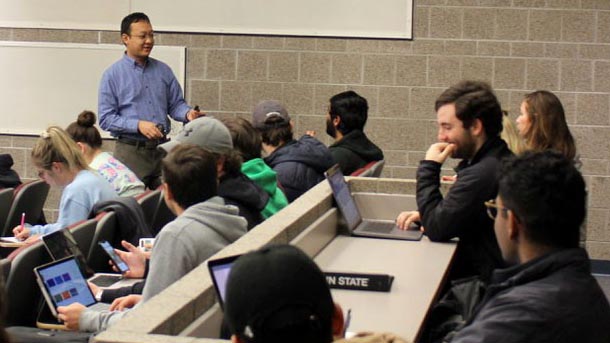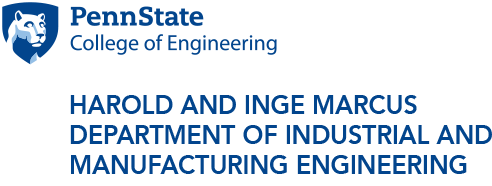
Zhang engages with a student in his IE460 Service System Engineering class. IMAGE: ANDREW SEVERIN
Industrial engineering professor teaches students to balance learning and earning
4/29/2019
UNIVERSITY PARK, Pa. — For a company to operate at optimal levels, it must first understand how to balance its learning and its earning. A company must learn how the market reacts when it conducts business in certain ways, but the company cannot risk being unprofitable during this learning period. This is a dilemma that many businesses face while striving for optimal performance. And, it is a dilemma that Penn State industrial engineering (IE) graduates are well equipped to resolve.
Penn State Assistant Professor of Industrial Engineering Huanan Zhang stresses the importance of balancing learning and earning in real-world operations. Through his research, Zhang identifies ways to balance these ideas in the fields of pricing and inventory management. Though, Zhang warned this is easier said than done.
“Conceptually, this is easy. We just balance the learning and earning. However, we need to have a more scientific way to determine when you should learn and when you should earn,” he said. “What I do is propose learning algorithms for each specific system.”
Learning algorithms are the conductors that guide decision makers in balancing these two ideas. In one area of research, pricing, Zhang developed learning algorithms to answer one fundamental business question.
“How do you charge a price for a product in order to maximize your profit?”
In order to find the price for a product that maximizes profit, a firm needs to perform price experiments. Price experiments compute the profit on a product sold at various price points, to help understand how price affects demand. Without the right learning algorithm in place, companies risk operating at inefficient levels for too long.
“If you are focused on learning, you are spending a lot of time at an inefficient price point. If you charge a price that is too high for even a week you lose the opportunity for that week,” he said. “If you’re only focused on earning, you’ll end up using historical data for a price point that might be far away from optimal.”
Zhang expands the idea of balancing learning and earning to his other research as well. Most of his research explores the supply chain concept of inventory control.
Inventory control problems are very challenging because they often suffer the curse of dimensionality. The curse of dimensionality says that, as more dimensions or features are added to a problem, the amount of data needed to predict its outcomes increases exponentially. It not only creates a computational challenge, but also greatly slows down the convergence speed of a learning algorithm, if one directly applies an existing online or reinforcement learning algorithm.
Zhang is working on providing timelier solutions to the curse of dimensionality. Specifically, he is developing a learning framework that reduces the number of “periods” of data collection needed to solve complex inventory control problems. Periods, as Zhang explained, are equivalent to days. Reducing the time needed to solve a curse of dimensionality inventory control problem means companies can find relevant solutions to immediate needs.
“Say for example I proposed a learning algorithm for an inventory problem that takes 1,000 periods to see some convergence. That’s pretty much like three years. Things must have changed within those three years,” Zhang said. “(With our learning algorithm) in less than 50 days we see very strong convergence for a very challenging problem.”
Providing solutions in 50 periods, as Zhang explained, is fast enough that circumstances probably haven’t changed, and the solution is still relevant. The quickness of decision making also helps balance learning and earning. Simply put, discovering a solution means a company can spend a longer time at optimal inventory levels.
In his graduate engineering course, Supply Chain Engineering, Zhang teaches students to use data-driven decision making in applied supply chain. He wants students to get rid of the mindset that practicing supply chain engineering is like solving homework problems. Instead, Zhang uses case studies and creative collaborative projects to teach supply chain concepts. He likens his approach to training a primary care doctor.
“As supply chain engineers, we want to be a primary care physician for a company for their supply chain. We may not be able to get into the specifics of every problem but we do know the diagonals,” Zhang said.
In real-world supply chain systems, problems won’t be presented as they are in homework or textbooks. That is why Zhang teaches students to understand the whole supply chain system. In that way, diagnostics in supply chain systems would mirror the diagnosis of a patient.
“(In theory) you learn what the textbook tells you. If you see these types of symptoms then the patient has this type of sickness,” he said. “In practice, it’s about the whole person. You have to be able to identify the problem. The problem is not presented to you. It’s the whole person or the whole supply chain that’s presented to you.”
Runsang Liu, a master’s student studying IE, completed Zhang’s Supply Chain Engineering course and is now working on a project with Zhang and Assistant Teaching Professor Charles Purdum. Liu echoed Zhang’s assessment of his teaching style.
“(Zhang) teaches with examples, where other professors can be more abstract. He does a good job showing us how to use the mathematics we have learned in the real world,” he said.
Aside from his teaching philosophy, Zhang is very approachable and always willing to help students, Liu said. “He helps me organize my materials to present to our client, to make it more persuasive. At one point, he was very honest with me that my work needed further computation. He helped me develop four models that I eventually presented to our client. Their response was that they were very pleased with the work I had done.”
If you would like to learn more about Huanan Zhang, you can visit his website. For more information, or to learn how to get involved with SEE 360, contact Bárbara Venegas at 814-863-5742 or bbv105@psu.edu.
For more updates from Service Enterprise Initiative 360, visit see360.psu.edu.



